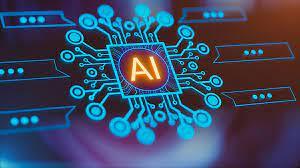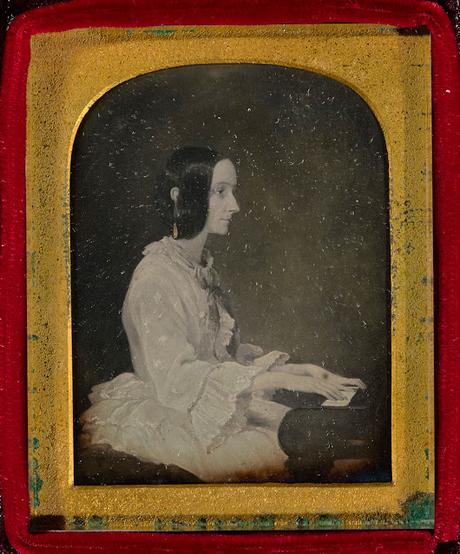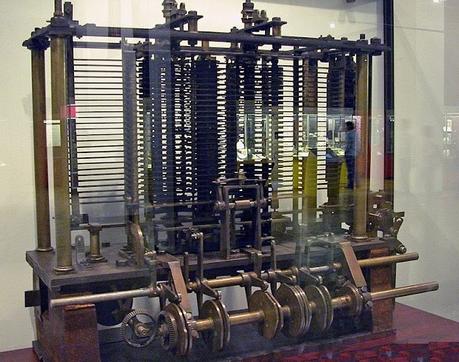 Well, that seems fairly straightforward, let’s just check up on wiki about what may lie behind solving these complex tasks:AI researchers have devised a number of tools to solve these problems...Bayesian networks are a tool that can be used for reasoning (using the Bayesian inference algorithm) learning (using the expectation–maximization algorithm)...Probabilistic algorithms...perception systems analyze processes that occur over time (e.g., hidden Markov models or Kalman filters).Ok, so I’m a bit weak on Bayesian inference algorithms so how did we get to the point that we can be even talking about such things. And for that I’m going to go back to the very beginnings of computing. Back to 1836 and Cambridge University mathematician Charles Babbage and Augusta Ada King, Countess of Lovelace who invented the first design for a programmable machine, known as the Analytical Engine. Babbage outlined the design for the first mechanical computer, while Lovelace foresaw the machine's capability to go beyond simple calculations to perform any operation that could be described algorithmically.Augusta Ada King, Countess of Lovelace was born Augusta Ada Byron on 10 December 1815, the only child of the poet Lord Byron and his wife Anne Isabella Byron. Augusta was named after Byron’s half-sister, Augusta Leigh, and was called ‘Ada’ by Byron himself.
Well, that seems fairly straightforward, let’s just check up on wiki about what may lie behind solving these complex tasks:AI researchers have devised a number of tools to solve these problems...Bayesian networks are a tool that can be used for reasoning (using the Bayesian inference algorithm) learning (using the expectation–maximization algorithm)...Probabilistic algorithms...perception systems analyze processes that occur over time (e.g., hidden Markov models or Kalman filters).Ok, so I’m a bit weak on Bayesian inference algorithms so how did we get to the point that we can be even talking about such things. And for that I’m going to go back to the very beginnings of computing. Back to 1836 and Cambridge University mathematician Charles Babbage and Augusta Ada King, Countess of Lovelace who invented the first design for a programmable machine, known as the Analytical Engine. Babbage outlined the design for the first mechanical computer, while Lovelace foresaw the machine's capability to go beyond simple calculations to perform any operation that could be described algorithmically.Augusta Ada King, Countess of Lovelace was born Augusta Ada Byron on 10 December 1815, the only child of the poet Lord Byron and his wife Anne Isabella Byron. Augusta was named after Byron’s half-sister, Augusta Leigh, and was called ‘Ada’ by Byron himself.
Augusta Ada King, Countess of Lovelace
Ada was brought up by her mother, who educated her as a mathematician and a scientist in order to avoid the ‘poetic’ influences of her father’s nature. Ada was a bright and curious child, and from her early years experimented with mechanical things. She described her approach as ‘poetical science’ and herself as an ‘Analyst (& Metaphysician)’.As a young adult, her mathematical talents led her to an ongoing working relationship and friendship with Babbage. In particular Ada was enthralled by Babbage’s plans for the Analytical Engine. Between 1842 and 1843, she translated an article by Italian military engineer Luigi Menabrea on the engine, which she supplemented with an elaborate set of notes of her own, simply called Notes.Her notes not only presented the first documented computer program, but also, going well beyond Babbage’s ideas of computers as manipulating numbers, outlined their creative possibilities. She famously wrote:
‘The Analytical Engine weaves algebraic patterns just as the Jacquard loom weaves flowers and leaves.’
She also identified the limits of what computers can do, in a remark highlighted in one of Alan Turing’s most famous papers as ‘Lady Lovelace’s Objection’.

the Artificial Engine
Lovelace had wide scientific interests and she speculated in a far-thinking way on the potential of mathematics and computing: for a “calculus of the nervous system”, or to investigate music.She died at the age of 36 – the same age that her father had died – on 27 November 1852. She was buried, at her request, next to her father at the Church of St. Mary Magdalene near Lord Byron’s ancestral home at Newstead Abbey. In 1993 a blue plaque was erected at her home at 12 (formerly 10) St James’s Square, London, in commemoration of her being a ‘pioneer of the computer’.– Liz McCarthy, Bodleian LibrariesExtraordinarily I cannot find a poem about Lovelace by a recognized poet anywhere. This needs to be rectified.In the meantime I couldn’t resist asking an AI website for help. Here is what it came up with after shoving in a few words from the above:
Untitled
In the realm of verse and rhyme, a marvel to behold,
A computer program, with AI to unfold,
Bayesian inference algorithms, at work so grand,
Creates a poem, with human in the land.
With each line, a new thought arises,
As the program learns, with each surprise,
The human touch, a gentle guide,
In this dance of words, they abide.
The computer hums, with logic so bright,
A poem born, in the digital light,
Yet, the heart and soul, a human's own,
In this collaboration, a symphony shown.
The words flow like a river's stream,
As the algorithm, with each line, it gleams,
The human in the loop, a vital part,
In this poetic journey, a work of art.
The poem's depth, a testament to the mind,
That with AI, a new art form we find,
A fusion of tech and human thought,
A new frontier, in the world we've sought.
Thanks for reading, Terry Q. (Or is it?) Email ThisBlogThis!Share to TwitterShare to Facebook
